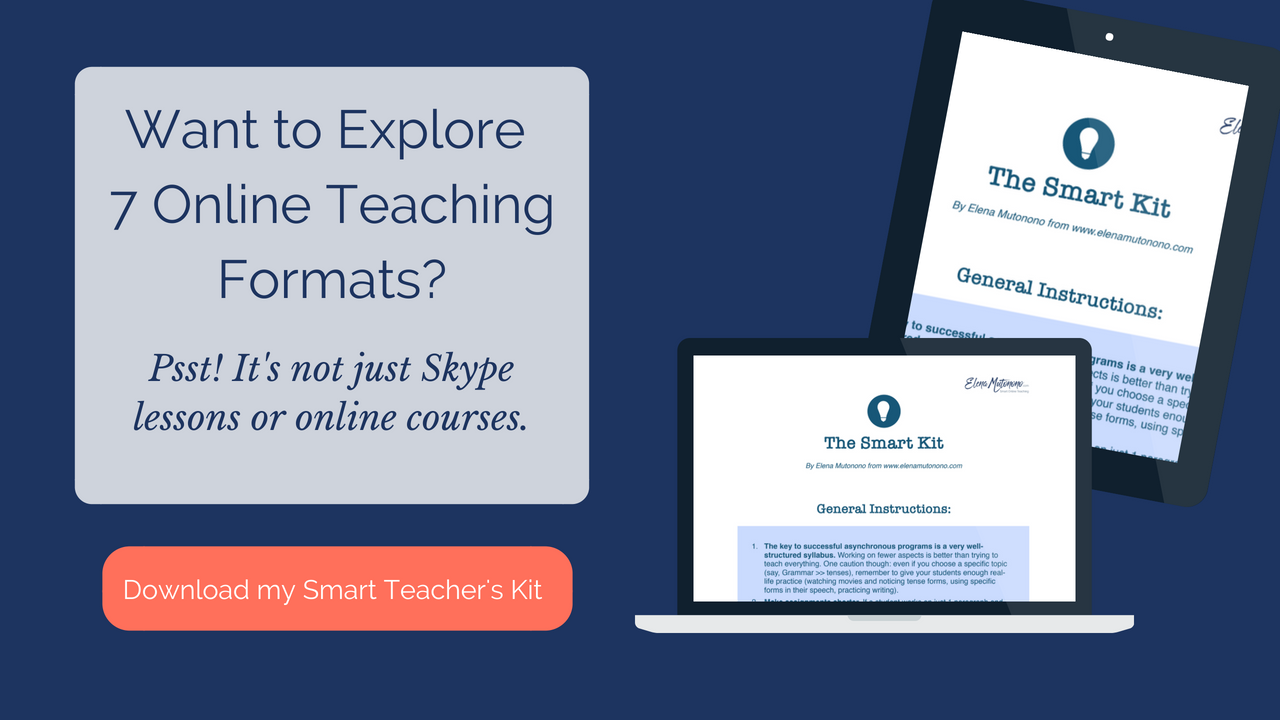It’s a new year, folks! Which means a lot of people are ready to get on with their resolutions. Many online teachers dream of a full schedule, being completely booked or having to squeeze juuuuust one more student.
Is that you?
I wonder why this is such a trend that doesn’t seem to give you any options. You take a course/listen to a webinar/read a blog post on online teaching, and everything seems to evolve around the following topics:
- Give as many trials as you can
- Convert as many students as you can
- Book yourself solid for 6 months in advance.
- Run facebook campaigns to bring in more students.
Yes... I Need Students, but What's Next?
Having read these posts (and written them myself) I at one point followed these tips and got me a full schedule. But what happens next?
- You continue squeezing in free trials, spending time and not knowing if it’s going to give you any return.
- You may not be aware of alternatives to free trials that teachers can have.
- You are busy as it is, but now you have to add more hours, deal with scheduling logistics and maybe even no-shows.
- You are still not guaranteed that these people will in fact become your clients.
In my informal conversations with online teachers I hear them lament about how little time they have between lessons, and yet there doesn’t seem to be any other alternative to a regular 1:1 free trial consultation.
Cutting Down on Free Trials
From a mini-survey in my Opted out group on Facebook this week, I’ve realized that about a 3rd of all the participants still give at least 4 free lessons a month – it’s 2 hours a month that can easily be gained back.
My post today isn’t how you can do a free trial successfully, but rather how you can do away with it (or at least cut down on it) so you can save more time, give chance to more prospects to participate in a trial lesson with you (or your free trial concept) and not worry about scheduling.
A manageable free trial #lesson format that is automated, scaleable and has 0 no-show risk. Click To Tweet
Free Trials Aren't Always the Smartest Time Investment
Back in the days when I was giving skype lessons practically non-stop I felt like a free trial lesson was an investment and that if I was able to convince a person to sign a contract with me (which most of the time I could), it would be time well spent.
When you think of it however, this model follows a traditional classroom (face-to-face) model where you can only take so many students. A free trial that lasts 30-minutes is limiting because if next month you received 200 free trial requests, you would spend 100 hours giving lessons for free.
That doesn’t sound as flexible and freeing as an online business should be.
Being more free is the reason I have *opted out* of the traditional classroom. Less time on endless paperwork that follows a 30-year-old standard guidebook designed by a former USSR communist party member who has never taught. Less time on gossiping in faculty meetings (nooooo, that would never happen!). Less time on worrying about how to make more.
******
Confused about online teaching?
In my book, I help you find focus (free digital journal included).
What Do People Say about a Free Trial Lesson?
According to my findings, though free trial lessons are losing in popularity as teachers are becoming more cautious about their time and less eager to please the freebie hunters, there’s still a lot of talk about running free/low-cost trials because after all we need to know what the students want.
Teachers argue that as long as they don’t teach anything in the allotted time it’s OK not to charge anything or to charge a lower price.
But…
Is time not worth as much as your expertise?
These days I don’t give free trials and I don’t even have low-cost consultations because I decided to change my mindset about the free trial concept altogether.
5 Ways to Make your Free Trial Less Time Consuming.
- Automate your “free trial” to save time.
- Encourage people to sign up to get access.
- Cut out unnecessary logistics and no-show risk by delivering it to the person’s email address.
- Provide value.
- Create a call to action within your free trial.
Below I want to introduce you to some “free trial concepts” that in my opinion are better than a traditional free skype trials because they don’t take any of your time, but provide students with enough information to help them decide whether or not they want to work with you.
I’m using these as examples and an inspiration for you. I also encourage you to use your creativity and resist mindless copying (because it just doesn’t work).
3 Examples of Free Trial Concepts that are Easy to Manage and Grow.

Example #1.
The first free trial concept is a copy writing email challenge for online teacherpreneurs by Veronika Palovska. Veronika’s 5-email mouthwatering series is designed for online teacherpreneurs who wish to create a website that speaks to the needs of the visitors, converting them into your fans.
Each email opened up a new world for me, and highly practical assignments made this series transformative and valuable (not to mention the beautiful design!).
But the main thing is, created once, this challenge remains. It might be tweaked in the future, but the essence is there. It’s automated, so it frees the author to do other things while more people are finding out about her valuable materials.
Who knows how many people will sign up right now because it’s so accessible? What if I told you, – hey, Veronika has taught me to write copy for this website, how about you book a free trial with her? Not sure you would do that right away, but signing up is easy and less intimidating.
Example #2.
Leandra King’s Guide on How to Fit In with Native English Speakers is a mini-treasury of eye-opening facts about native speakers of English and how non-natives can communicate without faux pas.
What I love about his guide is its beautiful design and unique tips and ideas that help expats learn the cultural aspect of the English language and apply it in their daily conversations with the native speakers so they feel more accepted into the new culture.
Again, nobody risks anything by downloading the guide, and it’s a great way to start a conversation with a potential student. In the case of skype lessons only, if you do not sign a contract with the student it’s harder to keep in contact with them.
Example #3.
Here’s a guide by Cara Leopold on how to use movies to understand fast-speaking native speakers. The guide includes a 10-part process to boost listening, a video example, followed by a 3-day active listening email course.
Cara’s training will help her potential students listen and understand. Frankly, I don’t think it would be possible to fit all that she’s offering into a 30-minute session.
The result though is that in 6 months since she launched her website the guide was downloaded by more than 600 potential students all over the world, over a dozen of them purchased paid packages and products in a few months.
Imagine giving a free trial to 600 people?! But Cara has, in the form of her guide, and hasn’t spent any time teaching each of those people individually.
In Conclusion...
I want to encourage you to be overprotective of your time. I don’t want to sound cliche, but we all know that we can’t recover the lost time. So before we give it away on trial lessons with new people that may not show up, let’s ask ourselves, can we do better? Can we be more creative and resourceful? Can we provide value without a direct contact with our potential client?
I hope you found this post helpful, and if so I’d appreciate you taking a minute and sharing it on social media!
If you still want to do a traditional free trial lesson but would like to streamline the process and cut down the no-shows, I’ve got this guide for you, too. Let me know what your challenges are when it comes to on-boarding new students.
This blog post was updated in March, 2021.






 Welcome to my nook where *Big Magic* happens. My name is Elena Mutonono, I help small business owners package their services as digital products and sell them online. I want you to work smarter, not harder. Increase your impact beyond your current face-to-face clients. Grow your business as you reach more people all over the world.
Welcome to my nook where *Big Magic* happens. My name is Elena Mutonono, I help small business owners package their services as digital products and sell them online. I want you to work smarter, not harder. Increase your impact beyond your current face-to-face clients. Grow your business as you reach more people all over the world.








Hey Lena,
First of all, thank you for including my challenge, it made my day to see it listed together with Leandra’s and Cara’s awesome resources – and I know they ARE awesome because I’m using them myself.
Creating a “passive” free trial is hard work, but it’s totally worth it. It’s like having an employee who works 24/7 so you can concentrate on other things – or take a break.
Just one year ago, I was spending my days (and often even nights) teaching 1:1 lessons.
Thank you for showing me that there’s an alternative to that exhausting lifestyle.
Now I can see that you can do everything – teaching, onboarding clients, marketing, networking, and so on – your own way.
Veronika, you’re right! Hundreds of people have downloaded my free e-books and signed up for the free list builder course – I know I would never have been able to a) provide them with so much value in 30 minutes; b) schedule and run all of these meeting on my own. Other “passive” sources can be a series of blog posts, podcasts or videos. It is a lot of work in the beginning, but it frees you up for the rest of the year. How cool! Thanks for your comment and for your brilliant resource!